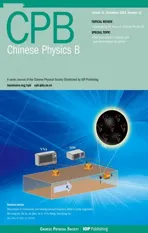Manipulation of intrinsic quantum anomalous Hall effect in two-dimensional MoYN2CSCl MXene
2022-12-28YezhuLv吕叶竹PeijiWang王培吉andChangwenZhang张昌文
Yezhu Lv(吕叶竹), Peiji Wang(王培吉), and Changwen Zhang(张昌文)
School of Physics and Technology,Institute of Spintronics,University of Jinan,Jinan 250022,China
Keywords: MoYN2CSCl MXene,quantum anomalous Hall effect,topological phase,first-principles calculations
1. Introduction
Research on two-dimensional(2D)materials arises from the exploration of graphene,[1,2]which has different properties from three-dimensional(3D)structures.Following the synthesis of Ti3C2, MXenes have aroused extensive attention in the last few years.[3–5]It represents a great family of 2D transition metal (TM) carbides that are chemically exfoliated from the layered MAX phases. The MAX phases host a generic formula of Mn+1AXn, in which M refers to an early TM, while A usually corresponds to the group IIIA or IVA element, and X represents C or/and N, withn=1–3.[6,7]MXenes which contain a single TM element, for example, Ti2C, Nb2C and Ti3C2have firstly been synthesized in experiments.[3]In these days, a new kind of MXenes containing ordered double TM elements,for example,Mo2TiC2and Cr2TiC2,have also been found.[7,8]
MXenes have exhibited an array of physical characters,for instance,metallicity owning excellent conductivity,[5]and half-metallic ferromagnetism.[9]The tantalizing topological properties of MXenes have been demonstrated theoretically.Undoubtedly, MXenes can be one of the best classes of materials for the exploration of the QAHE,[10]and it is possible to tune their spin–orbit coupling(SOC)strength and magnetism by replacing the transition metals or by changing the surfaces,[11]which opens rich possibilities of MXenes in numerous applications.
Different from quantum spin Hall conductivity protected from time reversal symmetry,[12,13]an intriguing quantum phenomenon with topological property, QAHE, appears with intrinsically broken time reversal symmetry, and is generically introduced by the internal magnetism.[14]The QAHE was originally predicted in theory by Haldane,[15]and described by the quantized Hall conductance without magnetic field.[16]Some 2D materials like TM doped topological insulators,[17–19]and TM decorated graphene,[20,21]are reported to harbor the QAHE in theory. Among these materials,a global band gap is generated around the Fermi level due to the adoption of SOC,giving rise to the topologically nontrivial character. In addition, the QAHE insulators are known as Chern insulators as well,[22,23]because of their nonzero topological invariant Chern number.
Owing to its dissipationless chiral edge state,the QAHE can be adopted to engineer next-generation high efficiency electronic devices.[24,25]Until now,diverse methods have been proposed to achieve the QAHE. Two recipes are frequently applied to combine magnetism with TIs, including doping magnetic atoms into TIs[17,26]and building a TI/magnet heterostructure.[27]The former is inclined to render the doped bulk inhomogeneous, leading to the low temperature for observation,which is detrimental to the formation of the QAHE.The latter may suffer from interfacial band bending.[27,28]Therefore,the acquired systems are usually not satisfactory.
Here, according to the first-principles calculations,we present the discovery of the intrinsic QAHE in the 2D MoYN2CSCl MXene. It is found that the monolayer MoYN2CSCl is a ferromagnetic QAHE insulator manifesting a direct band gap around 37.3 meV with topologically nontrivial property, hosting a room-temperature estimated to be 619.1 K. We will present structure and stability, electronic structure of the monolayer MoYN2CSCl. The edge states,Berry curvature and the conductivity are considered to affirm that the nontrivial topological characters of the MoYN2CSCl possessing a Chern number ofC= 1. We also discuss the band structures and topological phases of the MoYN2CSCl with respect to changing strains and controlling of magnetic axis direction,as well as different electronic correlation effect.The obtained abundant physical properties make the monolayer MoYN2CSCl an excellent candidate for prospective applications of the QAHE and spintronics devices.
2. Computational details
The first-principles calculations were carried out by utilizing the projected augmented-wave method as implemented in the Viennaab initiosimulation package(VASP).[29,30]The generalized gradient approximation (GGA) in the form of Perdew–Burke–Ernzerhof type was employed to describe the exchange–correlation interaction.[31]The vacuum buffer space larger than 15 ˚A was applied to prevent the coupling between adjacent slabs. The kinetic energy cutoff of the plane wave was 500 eV.During the structural relaxation,each atom could relax until the Hellmann–Feynman force was smaller than 0.001 eV/˚A.AΓ-centered 9×9×1 Monkhorst–Packk-point grid was utilized to sample the Brillouin zone. Besides, we included the van der Waals (vdW) interactions in all calculations. In consideration of the correlation effects of Y 3d electrons and Mo 3d electrons,we adopted the GGA+Uapproach withU=3 eV and 2.4 eV for Y and Mo atom, respectively.For the sake of better description on the topological characters,Berry curvature,edge states and anomalous Hall conductivity were also presented by the maximally localized Wannier functions by utilizing WANNIER90 package.[32,33]
3. Results and discussion
The equilibrium lattice constantsa=b=3.53 ˚A of the monolayer MoYN2CSCl are obtained via energy calculation.The MoYN2CSCl constitutes by seven atomic layers that stack in the order of S–C–N–Y–N–Mo–Cl,as illustrate in Fig.1(a),
where Y and Mo are transition metals. The local magnetic moment of the Mo atom is 2.089µB. Thus, Mo atom mainly contributes to the spin polarizations. After the structural relaxation, the atom sites and bond lengths slightly differ from those of the primitive structure.The structural stability is taken into consideration by calculating the phonon spectra, as is illustrated in Fig.1(b). No negative frequencies are found,indicating the dynamic stability of the MoYN2CSCl.
Then we calculate the binding energies by

whereEMoYN2CSClreprensents the total energy of the monolayer MoYN2CSCl, and other energies likeESandECrepresent the energies of atom S and C, respectively. The binding energy of the monolayer MoYN2CSCl has been determined to beEb=−30.98 eV,indicating that the monolayer can stably exist.
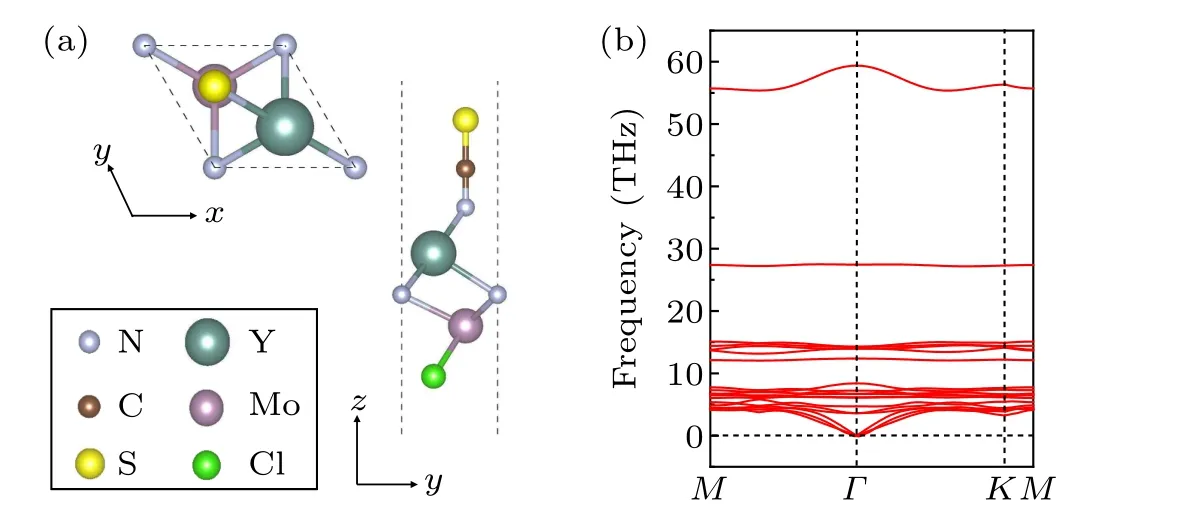
Fig. 1. (a) Top and side views of the atomic structure of the MoYN2CSCl.(b)Phonon spectrum of the MoYN2CSCl.
It is also important to examine the mechanical stability of the monolayer MoYN2CSCl by calculating elastic constants.In this 2D system, the elastic constants constitute a symmetric 6×6 tensor matrix.[34,35]The calculated results show thatC11,C12,C22,andC44are 560.3 N/m,167.8 N/m,540.7 N/m,and 194.9 N/m, respectively. The calculatedCijsatisfy with the Born criteria of mechanical stability[36]C11,C44>0 andC11C22−C212>0,which confirms the mechanical stability of the MoYN2CSCl. Due to the hexagonal symmetry,the monolayer MoYN2CSCl is mechanically isotropic. The 2D Youngs moduliC2D,shear modulusG2Dand Poisson’s ratiosv2Dcan be simply expressed as[37,38]
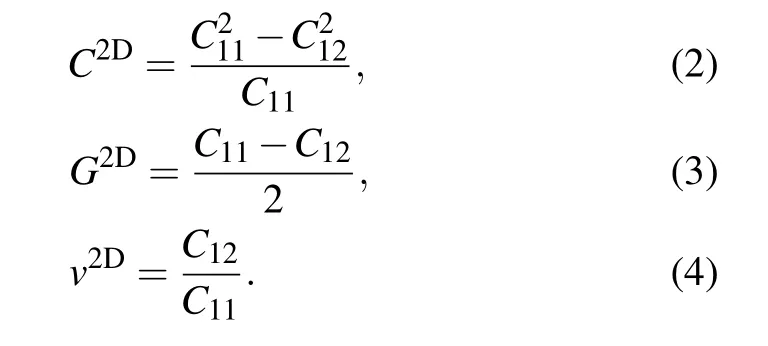
The calculated Young’s moduliC2D, shear modulusG2Dand Poisson’s ratiov2Dare 510 N/m, 196.3 N/m, and 0.299, respectively. The measured MoYN2CSCl possesses an ultrahigh stiffness, which is critical to avoid the curling of the 2D material.[39,40]
The magnetic ground state of the monolayer MoYN2CSCl is determined by comparing the energies of the ferromagnetic (FM) state and the three kinds of antiferromagnetic(AFM)configurations, as plotted in the Fig.2(a).The results determine that the FM order is the most stable magnetic state. To inspect the spin dynamical stability against temperature, Curie temperature (TC) is evaluated by utilizing Monte Carlo (MC) simulations, which is in the light of the standard 2D Heisenberg model expressed as

whereSiandSjare spin operator at sitesiandj,respectively,andJis the exchange coupling. Here, we use the variant expression

whereJijrefers to the exchange coupling constant fromisite tojsite,andArepresents the anisotropy energy parameter.SiandSjare the local magnetic moments atisite andjsite,whileSzimeans thezcomponent of spin vector. The summation runs over all nearest-neighbor Mo atoms. Taking into account the first nearest site pairs merely,for each magnetic atom,we can obtain

For a 2×2×1 supercell, there are four magnetic atoms and corresponding to 32 pairs of exchange interaction. However,each magnetic atom in the supercell can be treated as the nearest neighbor twice. Considering the repeated calculation, we obtain

Here,E′AFMandE′FMsignify the total energy of the AFM and FM configurations in the supercell, respectively. ThenJis calculated to be 14.63 meV,indicating the FM exchange coupling. At the same time, we calculate the heat capacity (CV)as follows:

Here, ∆ETrepresents that the alteration of the total energy accompanies the temperature rising fromTtoT+∆T. Figure 2(b) shows thatTCis estimated to be 619.1 K, which is expected to become a feasible member for spintronic applications with the high-temperature QAHE.
The comprehension of the microscopic origin of FM coupling in the MoYN2CSCl is that there exists a contest between direct exchange coupling (Mo–Mo) and the superexchange coupling (Mo–X–Mo,X= N or Cl), according to Fig. 3(a). There is a direct coupling between the nearestneighbor Mo, whose d orbitals have a direct overlap, leading to AFM coupling. It is proposed by the Goodenough–Kanamori–Anderson(GKA)rule[41,42]that the FM coupling is energy favorable with 90◦bond angle. Based on the Heitler–London model,[43]the approximate form ofJ ≈2k+4βSis reported,whereJrefers to the exchange integral in a 2D material. And the first termkis known as a potential exchange that is positive according to the Hund’s first rule.[44]The second term composes of the hopping integralβand overlap integralS. On account of the bond angles of Mo–N–Mo (102.14◦)and Mo–Cl–Mo (85.50◦) closed to 90◦, the Mo-d orbitals seem to be approximately orthogonal to the p orbitals of N and Cl, giving rise to an inappreciable overlap integral, then consequently a positiveJ ≈2k. As a result, the 2D monolayer MoYN2CSCl possesses an ordering of ferromagnetism according to the comparatively large FM superexchange interaction.

Fig.2.(a)Four magnetic configurations(FM and AFM-I,AFM-II,AFM-III).The arrows indicate the orientations of magnetic moment. (b)The simulated magnetic moment and specific heat(CV)as functions of temperature.
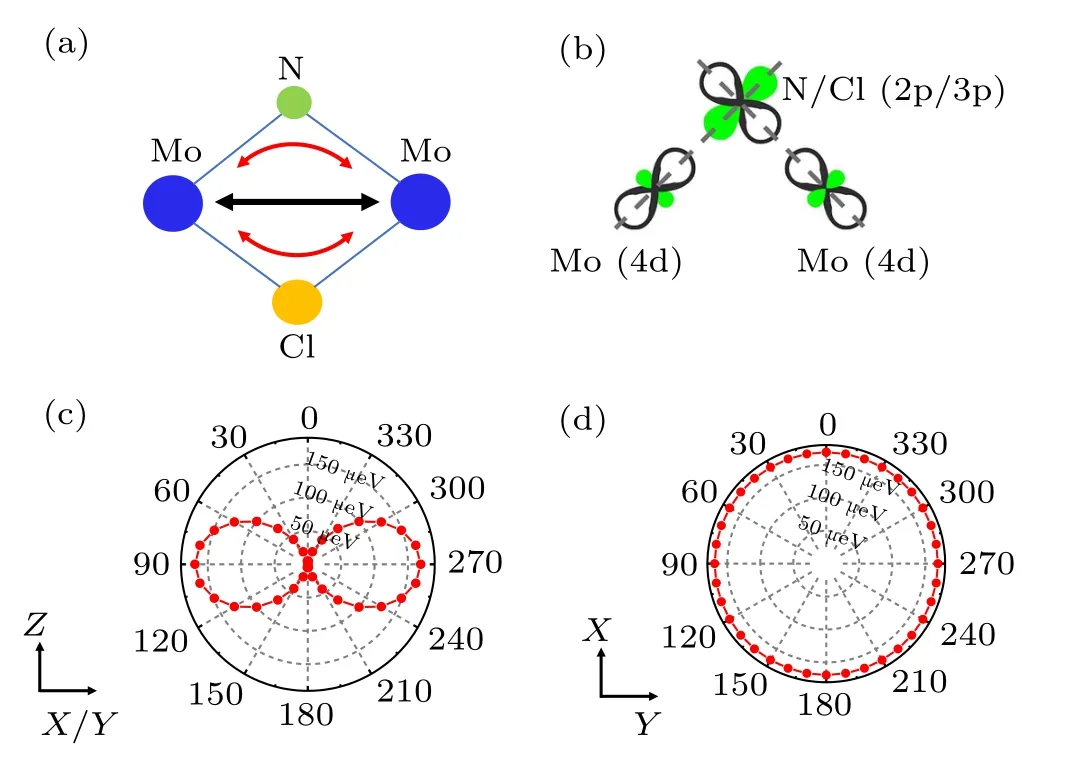
Fig. 3. (a) Schematic diagrams of direct exchange Mo–Mo (black arrows)and superexchange Mo–N(Cl)–Mo(red arrows)interactions. (b)Mechanism of superexchange interaction for the Mo–N(Cl)–Mo bond angle. (c)and(d)Variation of the MAE for the pristine MoYN2CSCl on the polar angle θ and azimuth angle ϕ,respectively.
Besides,magnetic anisotropy energy(MAE)denotes the energy required to change the magnetic moment orientation from the easy axis to the hard axis. The MAE, regulated by MAE(θ,ϕ)=E(θ,ϕ)−E(θ=0◦,ϕ=0◦)[E(θ,ϕ)refers to the total energy when the spin magnetic momentSpoints to the polar angleθand azimuthal angleϕ],is computed by rotating the spin magnetic moment along thexyandxz/yzplanes,as can be seen in Figs.3(c)and 3(d).We observe that the MAE strongly depends onθ,and hardly depends onϕ. MAE is calculated to be 0 atθ=0◦or 180◦, and attains a maximum value around 169 µeV within thexyplane, manifesting that the monolayer MoYN2CSCl is along out of the plane direction. The long-range order can be damaged if the heat fluctuation exists, but the large MAE obtained here is in favor of stabilizing this ordering at a relatively high temperature.
To get an in-depth understanding on electronic characters of the FM MoYN2CSCl MXene,we investigate the band structure in detail. Both GGA+Uand GGA+U+SOC band structures of the MoYN2CSCl are illustrated in Figs.4(a)and 4(b), as well as the corresponding partial band projections.The electronic structures of the spin-up and spin-down electronic orbits reveal distinct conducting behaviors. The monolayer MoYN2CSCl is a half-metal which offers 100% spin polarization intrinsically around the Fermi level. The spinup bands show a wide band gap, manifesting the insulating character,while the other channel possesses metallic conduction. According to theC3symmetry, the d orbitals of the Mo atom enclosed by the octahedral with distortion are divided into three parts dz2,(dxy,dx2−y2),and(dxz,dyz). Without SOC,the system is gapless with the degenerated Mo-dxz/dyzorbitals around theΓpoint between the valence and conduction bands.Additionally,we can see that the valence band at theKpoint is mainly contributed by Mo-dz2, as displayed in Fig.4(c). The degeneracy of dxzand dyzorbitals atΓpoint is protected byC3symmetry. When considering the effect of SOC,C3symmetry is broken, thus the doubly degenerate Mo-dxz/dyzorbitals split into two parts,leading to an energy gap with band inversion between them. Prominently,theEFin Fig.4(d)is within the SOC-induced band gap. The SOC induced band inversion is identified as the common mechanism of TIs. It is the heavy atom Mo in the MoYN2CSCl produces the strong SOC and results in an inverted energy gap. The energy gap of the MoYN2CSCl reaches 37.3 meV,which is crucial for the realization of the QAHE.
To testify their topological nature,the chiral edge state of the MoYN2CSCl is exhibited in Fig.5(a). We can clearly observe one metallic edge state existing along theΓ →Mpath,corresponding to the QAHE insulators. The QAH conductanceσxycan also be obtained in the light of Chern numberCas[45]andu(k)represents the periodic part of the Bloch function.

Within the energy gap range, the value ofσxyis exactly quantized toe2/h, and consistent withC=1, as plotted in Fig.5(b).At the same time,figure 5(c)indicates that a nonzero Berry curvature appears around theΓpoint,which agrees with the calculated chiral edge states.
Applying diverse strain may have an impact on the electronic structures of materials. Figure 6 exhibits the energy gaps of the FM monolayer MoYN2CSCl at different strains.The isotropic strain is defined as

whereaanda0denote the lattice constants of the strained and unstrained,respectively. Depending on Eq.(14),a negativeεrepresents the strain with compression, and a positiveεindicates the strain with tension.

Fig. 4. Band structure of the MoYN2CSCl with U =2.40 eV (a) DFT+U and(b)DFT+U+SOC. (c)and(d)The partial band projections of(a)and(b),respectively.

Fig. 5. (a) The chiral edge state of the MoYN2CSCl. (b) Calculated Anomalous Hall conductance of the MoYN2CSCl. (c) Berry curvature distribution within the first Brillouin zone.
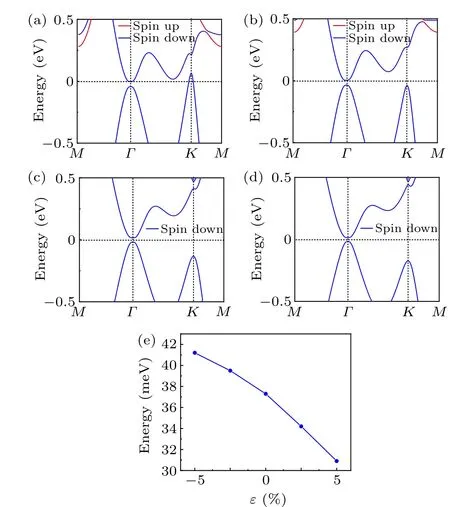
Fig. 6. Band structures of the monolayer MoYN2CSCl in the presence of SOC in ε =−5%(a),ε =−2.5%(b),ε =2.5%(c),ε =5%(d). (e)Monolayer energy gap as a function of biaxial in-plane strain.
For a monolayer MoYN2CSCl, the threefold rotation symmetry preserves with the varying biaxial strain. In the absence of SOC,the degenerate point near theΓpoint is insensitive with strain. In the presence of SOC,the bands around the Fermi level are really sensitive to applied strains,as plotted in Fig. 6. The energy gap decreases monotonously as the strain changes fromε=−5% toε=5%. In this case, the valence band energy at theKpoint decreases significantly.
However,the character of band inversion atΓpoint preserves. When applying the tensile strain, asεvaries from 0 to 5.0%,the monolayer structure possesses the robust QAHE.However,under small compressive strains,the nontrivial band topology vanishes atε=−5%, due to the gapless state between the bottom of conduction band and the top of valence band.
Besides,we consider the effect of magnetic orientation on the topological property. When the magnetic axis is in thezdirection,the monolayer MoYN2CSCl shows a Chern-number(C=1)phase. By turning the magnetization tox-direction,it reveals that the nontrivial topological property disappears,and the trivial topological property of the MoYN2CSCl originates from no band inversion between the dxzand dyzbands.
In this work, the electronic correlation[46–48]on band structures of the monolayer MoYN2CSCl are considered comprehensively by the GGA+U+SOC approach.The GGA+Ucalculation indicates their exchange energies are in connection with the effectiveUvalues. DiverseUranging from 0 eV to 3 eV are used for the Mo atom. Upon further increasingU,we find that without SOC the degenerate parts are getting close to the Fermi level,as plotted in Figs.7(a),7(c),and 7(e). When electronic structures of the MoYN2CSCl monolayer with SOC are calculated,the degenerate part atΓpoint turns to an energy gap,whose size is in direct proportion to theUvalue. As we can see in Fig.7(f),the gap reaches 43.1 meV whenU=3 eV.

Fig.7.Band structures of the monolayer MoYN2CSCl in the absence of SOC in U=1 eV(a),U=2 eV(c),U=3 eV(e). (b),(d)and(f)Bands with SOC corresponding to(a),(c),and(e),respectively.

Fig.8. (a)and(b)Electronic structures of the monolayer MoYN2CSCl without and with SOC in U =0 eV. Red and blue curves denote spin-up and spin-down channels, respectively. (c) The corresponding three-dimensional view of the MoYN2CSCl. (d) The chiral edge state of the MoYN2CSCl in U =0 eV.
While there is a difference inU= 0 eV, without considering SOC, the electronic structure of the monolayer MoYN2CSCl is investigated, as illustrated in Fig. 8(a). Near the Fermi level, there are two inverted bands possessing opposite spins crossing, demonstrating the appearance of a 2D nodal-line semimetal.[49–53]While turning on SOC,figure 8(b)shows that a SOC band gap (∼111 meV) is produced along the nodal line and leads to the QAHE withC=1. One can observe that an edge state with nontrivial topological property appears inside the SOC-induced gap.
4. Conclusion and perspectives
According to the first-principles DFT calculations, we systematically investigate a 2D MoYN2CSCl monolayer,which is an intrinsic FM QAHE insulator with Curie temperature estimated to be 619.1 K.Significantly,the SOC induces a topologically nontrivial band gap of 37.3 meV possessing a Chern numberC= 1 induced by band inversion between dxzand dyzorbitals. Additionally, we research the manipulation of nontrivial band gap by utilizing strain and regulating magnetic axis from thez-direction tox-direction, which leads to a vanishing of nontrivial topological property. Including different HubbardU,we find that whenU=0 eV the MoYN2CSCl transforms to a nodal-line semimetal with Chern numberC=1. Furthermore, providing guidelines for future discovery and design,we expect experimental verifications of the QAHE in the monolayer MoYN2CSCl.
Acknowledgments
Project supported by Taishan Scholar Program of Shandong Province, China (Grant No. ts20190939), Independent Cultivation Program of Innovation Team of Jinan City(Grant No. 2021GXRC043), Shandong Provincial Natural Science Foundation (Grant No. ZR2020QA052), and National Natural Science Foundation of China (Grant Nos. 52173283 and 62071200).
杂志排行
Chinese Physics B的其它文章
- Editorial:Celebrating the 30 Wonderful Year Journey of Chinese Physics B
- Attosecond spectroscopy for filming the ultrafast movies of atoms,molecules and solids
- Advances of phononics in 20122022
- A sport and a pastime: Model design and computation in quantum many-body systems
- Molecular beam epitaxy growth of quantum devices
- Single-molecular methodologies for the physical biology of protein machines
